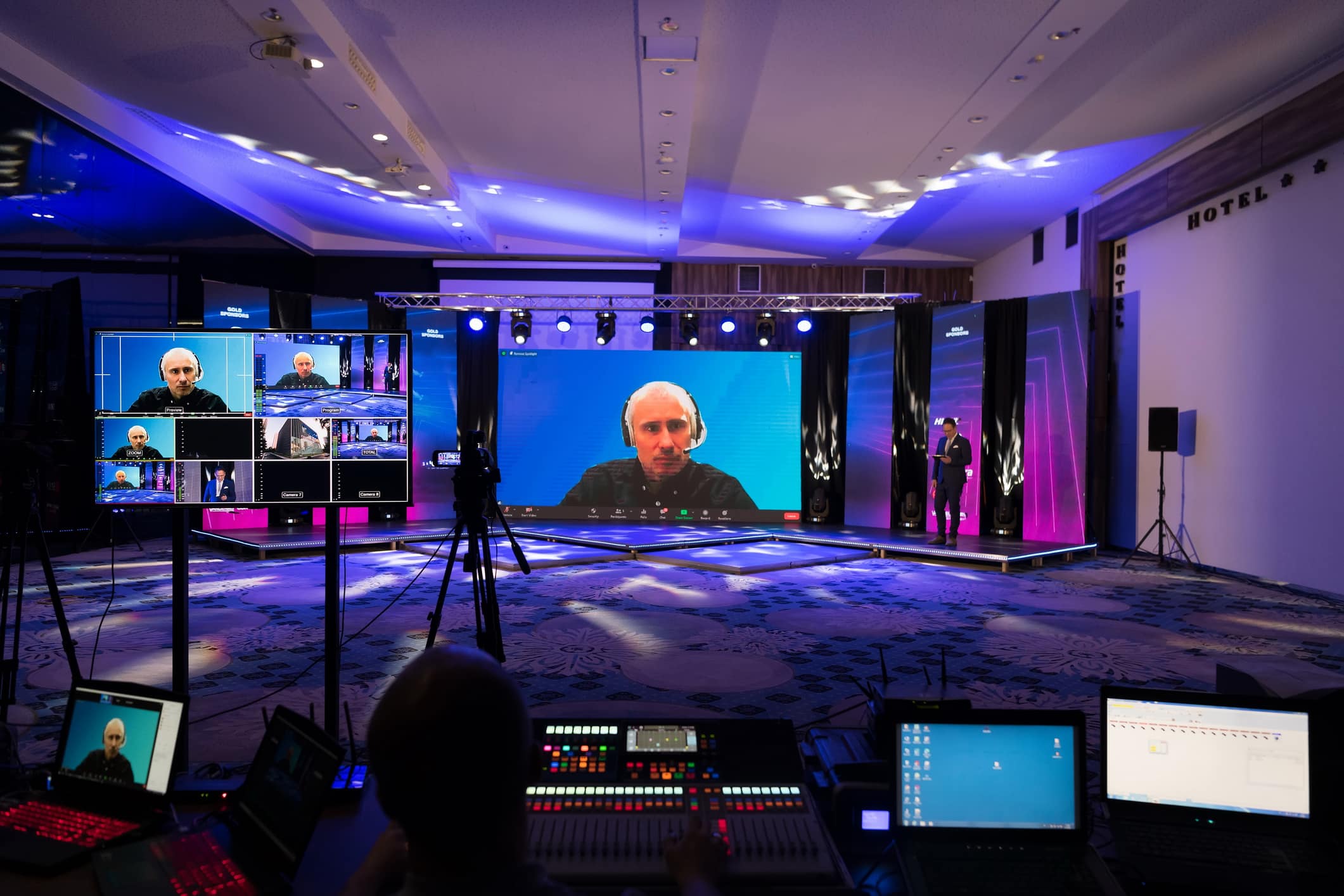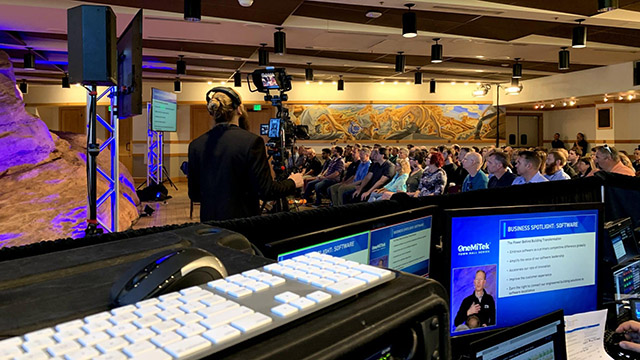
Industry Insights
Hybrid Events
Spot Content Studio’s 2022 Hybrid Event Guide
The future of corporate events isn’t in person or virtual; it’s hybrid. And when it comes to a successful hybrid event, simply scaling down and recording a live, in-the-room event for viewers at home just won’t cut it.
After more than a year of cobbled-together webinars and zoom meetings, isn’t it time to give your target audiences a little more?
A truly meaningful hybrid event—whether it’s a global town hall or a product launch—gives each set of attendees, on-site and virtual, an immersive, interactive experience. It blends the physical and the digital, so every one of your viewers and guests goes away with a better understanding of your message and a stronger impression of your brand.
In this hybrid event guide, we’ll define what a successful hybrid event is and isn’t, run through the basic elements of a hybrid event, and troubleshoot some technical challenges you may encounter as you plan a successful hybrid event for your organization.
So, put aside your expectations of keynote speakers and one-way conversations. We’ll tell you what will move the needle, now that advanced hybrid platforms and designs are taking off.
What a Hybrid Event Is – And Is Not

Today’s audiences demand more than a Facebook livestream. And, thanks to some accelerated technology-development driven by necessity (that is, a worldwide pandemic), hybrid event platforms and producers are more innovative than ever.
Keep in mind…
Zoom meetings are NOT hybrid events.
An event that consists of a camera recording an in-person conference session is NOT a hybrid event.
An app that asks trade show attendees to complete a short survey is NOT a hybrid event.
A true, successful hybrid event requires a virtual element that is just as much an experience as the in-person element. It should go way beyond the exhibition stand or the seminar to take advantage of everything the digital space has to offer. And for a seamless, memorable experience, your in-person attendees and your virtual attendees should be able to communicate and interact.
Think about it this way: when you plan for the virtual space, you’re no longer constrained by architecture. You can play around with different formats and engineer a virtual experience that blends with and enhances an in-person experience. You can tell your brand’s story in a completely immersive way.
Elements of Successful Hybrid Events
There are several key elements to keep in mind as you plan your organization’s next hybrid event. Here are the ones we think are most important:
- Your “Why” – One big challenge for many event planners is remembering all the reasons an organization is hosting the event in the first place. Understanding the “why” behind the experience you plan is step number one.
- Goals and Success Criteria – Once you’ve established an overarching purpose, it’s time to define your outcomes. Are you launching a new product or generating more sales? What numbers or benchmarks will help you know you’ve reached your goals? Select a few key metrics that will help you measure your event ROI.
- A Venue – You’ll want to select an in-person event venue with the solid infrastructure and bandwidth you need to make the experience for both your in-person attendees and your virtual attendees problem-free.
- The Right Event Platform – You’ll also need the technology required to transmit the programming you develop and keep your virtual guests engaged.
- Engaging Content – A cool technology stack can’t compensate for event content that isn’t worth your audience’s time. It’s important to not only have speeches or presentations that put the right message across to your attendees, but to also develop a storyboard and bring a producer on board who can curate the presentation for a virtual audience. In short, you need to think about content differently.
- Marketing and Logistics – Robust marketing—including ads, digital previews and event swag – and an easy registration process for attendees are key to driving attendance and giving guests a pleasant event experience. Don’t forget to consider on-site management and event organizers as you finalize your budget.
Once you’ve got the basics down, you can start to imagine just how creative and polished you want your presentation to be. Consider a format that creates a more engaging experience for virtual attendees, such as graphical layouts that include speakers alongside the visual elements of their presentation. You’ll want to keep connectivity in mind as well, which may include 2-way communication or live-stream. Any way you arrange it, your physical presenters and virtual aspects should appear seamless. This will give your audience a memorable experience that keeps the conversation going.
Our advice? Put yourself into the shoes of your audiences, both in person and online. Think about how you’ll provide opportunities for Q&A, chat, networking or other forms of interaction, and how you can make communications between these audiences feel meaningful—not contrived.
Finally, communicate as early and often as possible with your guests and viewers. Your attendees should know exactly what to do to join and participate in your event, whether they’re flying in and booking a hotel room or logging in from their bedroom.
Hybrid Event Examples to Consider as You Plan Your Next Event
You may already know that you’re planning a hybrid convention, product launch or conference. But you may not yet know how to take it from traditional and in person to hybrid. We can suggest a few models that have proven to be effective:
The Single-Venue Hybrid Event
This common type of hybrid event features a central in-person occasion at a single venue. Any presentations or activities are then amplified to a wider audience on a virtual platform. This may be what first comes to mind when you think of hybrid events. The challenge with this model is developing creative, interactive ways to make the experience meaningful for every person who tunes in.
The Network Hybrid Event
This type of hybrid event involves two or more in-person events that are executed simultaneously and are connected via a virtual touchpoint. It’s an interesting model to consider because it gives in-person attendees a more intimate on-site experience combined with access to other digitally connected groups. Keep in mind that to pull off this type of hybrid strategy and bridge communication gaps takes pretty robust technology.
The Hub and Spoke Hybrid Event
This last model combines the other two types of hybrid events. It features both a main, in-person event that is broadcast out to smaller in-person gatherings in other locations. This type of event can generate a lot of excitement because it has the energy of a large, major event along with the reach of a virtual event.
Technical Considerations and Costs to Include in Your Hybrid Event Budget
When it comes to providing a virtual experience, not just an in-the-room camera feed, there are several technical considerations to keep in mind. Remember that you’re not just adding a streaming provider to your expense sheet. You’re looking for a way to connect your audiences on the right event platform.
As you plan your event budget and research different event platforms, funding considerations should include:
Hybrid Event Production and Technologies
There’s significantly more to think about with hybrid and virtual events. To ensure the kind of quality broadcast that will impress your audience, you may want to consider hiring a remote or on-site event producer to help. You’ll need, at minimum, a webcasting or streaming console, a content delivery network and hosting for both the virtual event and any on-demand content you’ll provide to your audience later.

Virtual and Physical Spaces
You need a physical venue for in-person guests, and a virtual environment as well. The two would ideally merge so that both in-person and virtual attendees feel connected and the hybrid experience feels as seamless as possible.
Hosts and Moderators
A good host can bridge the gap between in-person and virtual audiences and provide a better experience for all attendees.
Advances in technology—and the right experts—can help you make all of this happen. A truly hybrid experience can be accomplished by utilizing two completely different crews, one for each experience, or utilizing a partner that has the equipment and the expertise in delivering two distinct outputs.
A note about hybrid platforms: all platforms have positives and negatives, so it’s important to do your research and identify the features that are most appropriate for your event. Similarly, when it comes to corporate events there are different internal IT considerations involved. It’s very important to have discussions with your organization’s IT department and make sure that the streaming plan you choose works well for both your internal network and the public internet if people will be participating from home.
Questions to Ask Yourself as You Get Started
When you’re trying to plan for nothing less than the future of corporate events, it can be hard to know where to begin! We recommend keeping these questions in mind as you get started:
- Who is your event for?
- Why should your audience attend in person or virtually?
- What outcomes do you hope to see from this hybrid event?
- What brand message do you want to get across, and what format will best drive awareness?
- What will your in-person and virtual sessions or presentations look like?
- What technology or content gaps do you need to fill?
- Are you working with event professionals in the hybrid events industry?
- How will you facilitate breakout sessions, collaboration and networking?
- How will you measure success?
- How will your event stand out from the crowd?
Common Challenges to Avoid and Virtual Engagement Tips
The most common challenges we see have to do with presenting both in-person and virtual content and providing the right connectivity to audiences.
Combining live and virtual presenters can require some extra experience and finesse to pull off correctly. This challenge can often be overcome by bringing presenters into the studio and using some extra pre-show testing to work through any issues that arise from the addition of remote presenters.
Another big area in which we see issues is the internet connectivity of remote presenters. When developing a hybrid event, every participant’s internet connection needs to function correctly to pull off a flawless presentation. You’ll want to have a contingency plan in place to deal with technical or connectivity issues as they arise so, as they say, the show can go on.
Remember, your audience already knows how to watch a video or complete an online tutorial. So, give them more.
Today’s virtual corporate events can be more polished than ever, and you have an opportunity to wow your attendees with a seamless, highly engaging hybrid event. We think it’s helpful to design for your online audience first, and then blend your virtual plans in with the in-person activities you have in store. Consider adding influencer elements, breakout rooms or AI matching for networking opportunities, or at-home perks and product samples to make each guest feel like a VIP. Ultimately, you want that line between in person and virtual to blur.
Final Thoughts from Spot Content Studio
To pull off a highly engaging virtual event, you’ll need to be prepared for multiple issues that may arise. That’s why it’s important to work with a producer who is not only well versed in AV support, but in broadcast production as well. A good producer knows established broadcast techniques that hold an audience’s attention. Using visual and audio techniques captures the attention of your viewers and can help you reach the goals you set for your hybrid event. And Spot Content Studio creates contingency plans to deal with technical issues as they arise, so your attendees have a friction-free experience.
When it comes to our new hybrid reality, the right team makes all the difference.
